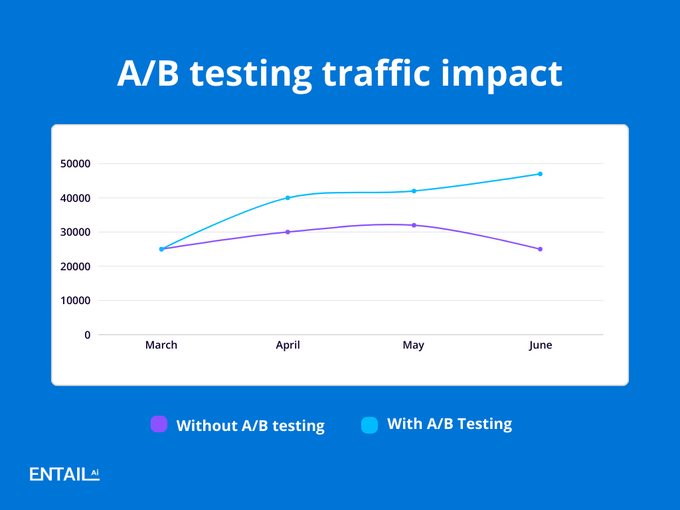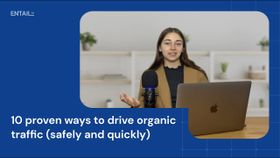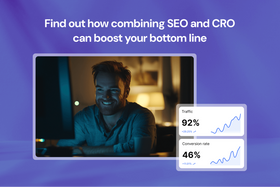SEO A/B testing: A step-by-step guide
If you manage a large website with lots of content, SEO A/B tests can help you learn what works best to improve click-through rates and conversions.
Updated March 27, 2025
When it comes to your website, you want to base your decisions on data, not opinion. You want to test things to see what works best and then implement the elements that show positive results. This is where A/B or split tests come in.
This systematic approach, built on data collection and analysis, allows you to justify decisions, accurately predict outcomes, and chart a path toward continual improvement over time. Without a proper testing and measurement framework, you're missing out on meaningful improvements in traffic and conversions.
Key takeaways
- While SEO A/B testing isn't as scientific and accurate as regular A/B testing, it can still provide valuable insights.
- To avoid penalties from Google, avoid specific issues related to the stability and reliability of your content.
- One of the biggest challenges of SEO A/B testing is effectively testing across multiple pages.
- The real value of SEO A/B testing is optimizing the user journey from content creation to marketing goal completion.
What is SEO A/B testing?
SEO A/B testing aims to increase your site's performance by simultaneously testing different versions of a page or elements within a page. Page elements include content, headings, meta tags, and calls to action (CTAs).
SEO A/B tests can improve:
Page ranking and click-through rate on SERPs, resulting in increased traffic
User experience and click-through rate on the page itself to help reach your marketing goals
» Learn more about A/B testing in digital marketing.
SEO A/B testing vs. regular A/B testing
In a regular A/B test, the traffic source is permanent, like with email marketing or a paid campaign. For example, you can send different versions of an email to segmented parts of your audience and see which performs better. The groups you target are fixed.
However, SEO A/B testing is different because the changes you make can alter the traffic itself, making it difficult to measure the impact of specific changes in isolation. Say you change the title of a page to improve traffic. It's almost impossible to attribute an increase in traffic to that change due to other influential factors like website authority, internal linking, and algorithm updates.
SEO A/B testing typically also involves testing broader concepts rather than specific changes. You might divide pages into groups and test different structural elements, such as headings or CTAs, to see which yields better results. It's not as measurable and scientific as the more traditional A/B tests used in performance marketing, but it’s still valuable for learning what works for your website.
READ MORE: What is CRO testing? (+ how to do it right in 2026)
Why run SEO split tests?
It always comes back to data. There are two main goals for the data gathered from split tests:
To learn the best techniques to increase traffic
To find ways to improve conversions
Unlike traditional A/B tests, SEO split tests rarely yield clear-cut conclusions because of the many factors influencing organic search performance. However, one primary goal is uncovering what content and tactics work best for your website.
Rather than blindly following general best practices, SEO A/B testing allows you to learn what Google favors for your unique pages and subject matter when it comes to improving rankings and traffic.
The second key objective of SEO split testing is to boost conversions from your existing content. If you have a large website operating at scale with multiple pages, there are likely significant opportunities to optimize user journeys and improve conversion rates. Testing different page elements, CTAs, and content funnels can lead to increased revenue from your current organic traffic.
How SEO A/B testing works
Begin by choosing a goal for the test. We’ve broken A/B testing into three primary goals, as these goals require slightly different approaches:
Improving rankings
Improving click-through rates
Improving conversions
Once you’ve settled on the goal, it's time to develop a hypothesis about the element or page you’re testing (in line with your goal). For example, I might hypothesize that longer pages will result in a higher ranking, that shorter titles will result in better click-through rates, or that certain CTAs will result in higher conversions.
Then, divide your pages or elements into two groups: the control group (the unchanged page or element) and the variant group (the changed page or element).
Next, run the test and gather information regarding your goal and hypothesis by closely tracking the difference between the control and variant over time. Lastly, analyze the collected data to confirm or deny your hypothesis.
Let’s look at specific examples of how you can implement this approach depending on your SEO goals.
SEO A/B testing to improve rankings
Let’s say you have a few pages that are about 1,000 words long. This has been your standard blog length, but you aren’t ranking well. You then hypothesize—we’ll use our earlier example—that longer pages will improve your SERP ranking.
You then create another group of pages built according to the hypothesis. Let’s double the length of the blog posts to 2,000 words. This would be your standard SEO A/B split test.
Keep in mind that you don't want to duplicate pages and make the content longer. You must create new pages to avoid potential penalties from Google.
The time period for testing is crucial. You want to let it run for at least a few months. While significant changes may show up within days or weeks, it can take months to see the full effects on SEO. Testing over a few months allows you to draw solid conclusions on whether the changes truly made a difference.
In any scientific test, you want to ensure that the environment in which you test is as sterile as possible. This means eliminating external factors that could change the result. Unfortunately, in SEO, many factors are beyond your control, so you need to use pages that are as similar as possible to see clean results.
Here are additional considerations to get better results from testing:
Use pages with a similar number of links pointing to them
Factor in the search volume each page targets
SEO A/B testing to improve click-through rate
Now, we come to the issue of not getting a lot of traffic even though you’re getting impressions. Testing different titles, meta tags, and meta descriptions could help entice searchers to click through to your site, but the point is to test your hypotheses and get the data to confirm them.
To continue the example, the change to 2,000 words per blog post has improved your rankings, but you have developed a hypothesis that shorter titles will improve click-through rates. Form the same control and variant page groups to establish if the title length creates a different trend from your longer titles.
Always analyze the data you gather during the test to get actionable insights and use them to inform your decisions going forward. It’s good practice to regularly test your ideas and improve according to what you learn from your data.
Once again, try to use similar pages to test your hypotheses and consider what external factors could affect the data, such as:
Where are the pages shown on the website?
Do the pages have a link in your site's main menu or not?
» Let us help you improve your click-through rates. Talk to an SEO expert.
SEO A/B testing to increase conversions
Often, SEOs don’t test at this level at all. If they do, it’s on a small number of pages and mostly bottom-of-the-funnel pages. To get an accurate test on your conversion rate, you need a lot of content and traffic to see real results.
Start by dividing your pages into the top, middle, and bottom of the funnel. This can help isolate where the user is in their search and what they need to take the next step in their journey. The stages of the user journey directly relate to the types of CTAs you will use to drive them toward completing your marketing goal.
» Discover call to action examples that get real results.
For top-of-funnel content where users lack purchase intent, you'll want to test navigational CTAs. The goal is to determine how to guide users further along their journey by directing them to more relevant mid-funnel content.
At the mid-funnel stage, use a combination of navigational CTAs and CTAs for conversion. The goal is either to continue to nurture users at this stage with content like product reviews or push them further down to the bottom of the funnel.
Test copy phrasing, value propositions, and CTA destinations to see what works best within the article's context, the context of each section of the article, and the user's funnel stage. Implement changes according to your data analysis and test regularly to stay ahead.
Best software for SEO A/B testing
There are quite a few challenges associated with SEO A/B testing that you need to overcome. The sheer scale of the test can sometimes be overwhelming, and various external factors can contaminate the data. Fortunately, there are tools to make the process easier.
Google Search Console
Use Google Search Console to measure the impact on rankings and conversions across different pages. While not perfect, Google Search Console provides the most reliable data. You would then export this data to spreadsheets, isolate pages, and build reports to analyze how rankings improve over time—a challenging but necessary process.
Entail's conversion rate optimization (CRO) software
To measure conversion rates specifically, you'll need dedicated analytics tools. The challenge is tracking the full user journey across hundreds of pages, which regular analytics platforms like Google Analytics aren't designed for.
The ideal solution is a tool built to map and optimize interconnected user journeys across your entire website. A specialized tool like Entail’s CRO software can handle the scale and complexity required to improve conversions effectively.
» Chat with us to see how we can optimize your SEO A/B testing process.
Challenges of SEO A/B testing
SEO A/B testing is necessary for optimization and achieving specific goals, but the process must be approached with caution. If you do something that could be interpreted as manipulation of the algorithm, Google will penalize your website, and you won’t see any improvement in traffic or increase in conversions.
We’ve highlighted three pitfalls to avoid when performing SEO A/B tests to minimize any negative effects.
Cloaking
Cloaking refers to showing search engines one type of content while showing users something completely different. Google has become extremely skilled at identifying cloaking and will issue severe penalties to websites that use it, potentially impacting the entire domain.
It's crucial to avoid anything that could be misconstrued as cloaking, as the consequences are not worth the risk.
Unstable pages
Another factor Google considers is page stability. Google wants to know that the pages it crawls and ranks contain reliable, high-quality content that will still be available when users click through from the search results.
Google prefers pages that are regularly updated to stay fresh and relevant. However, if your pages constantly change to the point where your content is unpredictable or unreliable, it can negatively impact your rankings.
Split testing at scale
A major challenge of SEO A/B testing is running simultaneous tests across potentially thousands of page variations and collecting useful data. Using those insights to optimize the hundreds of interconnected user journeys on your site is even more daunting.
Traditional methods just aren't effective when it comes to improving conversions at such a complex scale while maintaining a seamless user journey.
» Conduct split tests at scale without impacting SEO with Entail's CRO software.
Test, optimize, repeat
SEO is an ever-evolving discipline. User behavior, search algorithms, and best practices are constantly shifting. Therefore, an ongoing testing and optimization cycle is necessary to stay ahead of the curve. Regularly revisiting your hypotheses, running new tests, and implementing proven tactics will ensure your website remains finely tuned for maximum organic traffic, engagement, and conversions.





